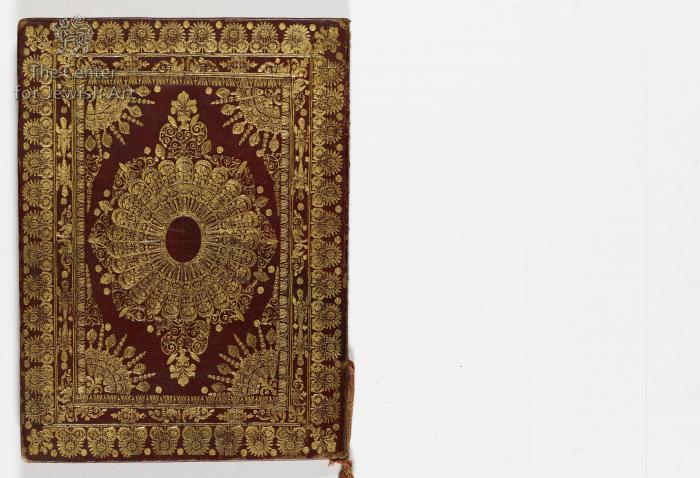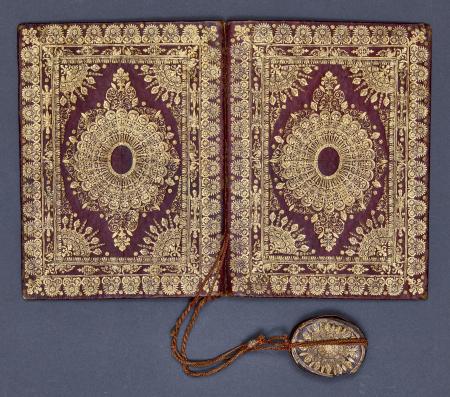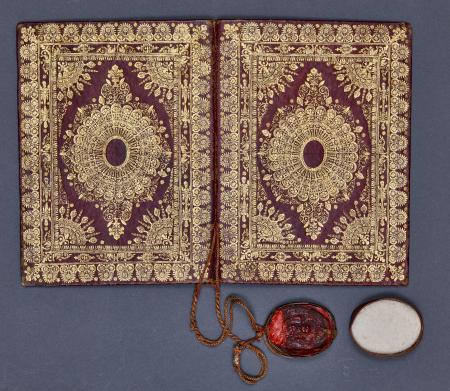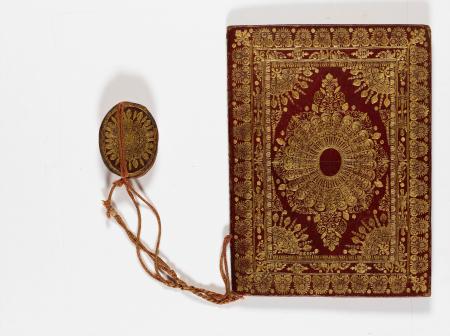Obj. ID: 53661
Hebrew Illuminated Manuscripts Medical Diploma, Padua, 1687

The following description was prepared by William Gross:
A lavishly illustrated and decorated medical diploma, this manuscript is one of a small number of such diplomas apparently by the same hand around this period. Such diplomas awarded to Jews are a great rarity. This one contains a portrait of the recipient, Moyses Tilche, as well as small portraits of Aristotle and Socrates. The pages are in an exquisite gold tooled leather binding with the original seal of the university largely intact. The only difference between the diploma for Jewish students and non-Jewish students was the use of the term "Anno Domini", "the year of our lord" for the Christians and the absence of that term for the Jewish students. Pages: 4
He was one of 325 Jewish physicians who graduated the medical school of the University of Padua between 1409 and 1816. This richly decorated diploma, composed in gold and black inks on vellum by the artist especially employed by the university to write and illuminate its diplomas, Jo. Aloysius Foppa, begins with the words “In dei aeterni nomine Amen” (in the name of the eternal God), rather than the typical “In Christi nomini Amen.” This was a small but significant consideration afforded Jewish students at the medical school, who otherwise faced difficulties such as having to pay double the tuition of Christian students. The diploma is signed by the professors who taught Emanuel: Antonius de Marchettis, professor of surgery; Joames Casparo Wolfus Ulmensis, and Nicolaus Caliaphius Cretens, professor of philosophy and rhetoric. Attached to the manuscript is a seal of the university, housed in a gilded leather casing. Between the 12th and 16th centuries, almost all European universities were under Papal control and Jews were restricted entry without compromise. Yet a singular exception to this was the University of Padua, established in 1222. As "Universa Universis Patavina Liberta" and outside of papal control, Jewish students were permitted to study and qualify for academic degrees. The Medical School, opened in 1250, was generally regarded as the best in Europe. The university’s tolerant and liberal approach attracted students the world-over, particularly drawing Jews from across Europe to Padua to study medicine. However, many of these young Jews initially lacked the necessary academic and cultural prerequisites, including a basic knowledge of Latin, the official language of the university. They therefore greatly benefited from the generous support of the Jewish community of Padua and, in particular, that of Paduan medical alumni, the best known of whom was Dr. Salomo Conigliano. Between the years 1409 and 1816, 325 Jewish physicians graduated from the University of Padua. Among them were many distinguished scholars including Joseph del Medigo, Joseph Hamiz, Benjamin Mussafia and Tobias Cohen. In addition to their medical contributions, many of these Jewish graduates served their communities as communal leaders. They all shared a common scholarly and cultural heritage, with common interests and values. Yet they also had the distinct societal advantage of maintaining close contacts with their Gentile peers. It was customary, upon graduation, to commission diplomas in the form of richly decorated booklets and the format and style of these diplomas was unique to universities in Northern Italy. The text of the standard diploma, however, included references to Christianity which were unsuitable for the Jewish graduates. The university, demonstrating considerable tolerance, allowed for the alteration of the customary Christian formulae. Whereas the standard diplomas from Padua began with the words "In Christi Nomine aeterni" and recorded the date as "Anno a Christi nativitate," diplomas created for Jews substituted these phrases with "In Nomine Dei aeterni" and "currente anno.” On the Jewish graduates of medicine at the University of Padua see: Abdelkader Modena and Edgardo Morpurgo, Medici e chirurghi ebrei dottorati e licenziati nell'Università di Padova dal 1617 al 1816 (Bologna, 1816). Emanuel Delmedigo de Dattolis came from a Jewish family of Venice. He is noted by Asher Salah in his La République des lettres. Rabbins, écrivains et médecins juifs en Italie au XVIIIe siècle (2007) p. 188 and 276.
Notes on Graduate: Moshe ben Gershon Tilche is a signatory to a letter published in Shimshon Morpurgo’s (see below) Shemesh Tzedaka, affirming the latter’s decision not to force the Ashkenazic community in Italy to abandon their custom of donning tefillin on ḥol ha-mo‘ed (intermediate days of the holiday). While Tilche is identified here as a rabbi and not as a physician, he appears to be our graduate. The Italian name Pellegrino is the equivalent of the Hebrew Gershon.
Notes on Tilche Diploma: The same figure identified by some as a rabbi in Emanuel Colli’s diploma appears here alone, and above his head is the shortened name for Hippocrates. He is thus not a rabbi as some have suggested, rather a medical sage.
Below the portrait are putti holding a laurel wreath, a book, a ring, and a hat. This is a remarkable and unique illustration of the features of the graduation ceremony at Padua, which was typical for European universities at this time. In addition to placing the wreath and hat on the graduate, a ring was placed on his finger. Books were symbolically opened and closed to represent the transmission of knowledge.
Date: The Christian reference of the date is omitted and the date is given as “currente anno” (current year)
Witnesses: The two witnesses for Tilche’s diploma were the Jewish physician, and graduate of Padua, Isaac Vita Cantarini (AKA Yitsḥak Ḥayim Cantarini) and the Jew Samuele Pace. Cantarini was a rabbi as well as a physician and was a prominent figure in the Padua Jewish community. Cantarini was both the author and recipient of poems dedicated in honor of Padua medical graduates.
Artist: Foppa. This diploma has the hallmark fly.
This letter is appended in Shemesh Tzedaka (Venice, 1743) to n. 14, 28a. The pagination is confusing as the headings of the lengthy responsum n. 14 are sometimes labeled as n. 4 (omitting the yod) and sometimes mislabeled as n. 15. See also Salah, Le Republique des Lettres, 630.
For further discussion of this particular controversy, which involved a number of prominent rabbinic authorities of the time, as well as for broader treatment of the clash of Ashkenazi and Sephardi customs in history, see B. S. Hamburger, Gedole ha-Dorot ‘al Mishmar Minhag Ashkenaz, 2nd ed. (Bnei Brak: Makhon Moreshet Ashkenaz, 5754), esp. 43–44.
See M and M, 46. There is mention of a Moshe Tilche of Livorno and related Gershon Tilche in the responsum of M. Yisra’el (1680–1740), Mas’at Moshe (Istanbul, 1734), Ḥoshen Mishpat, 64. The Tilches in this case were involved in a financial arrangement that was the substance of the legal responsum. This also likely refers to our graduate.
For extensive bibliography on Cantarini, see, Asher Salah, La Republique des Lettres: Rabbins, Ecrivains et Medecins, Juifs en Italie au XVIIIe Siecle (Brill: Leiden, 2007), 120-124.
Reichman
I am familiar with the Magnes diploma. In fact there is a figure in this diploma who also appears in your diploma. The curator from Magnus suggests he is a rabbi, but it is clear from your diploma that it is a picture of Hippocrates. Below are my notes on that diploma.









